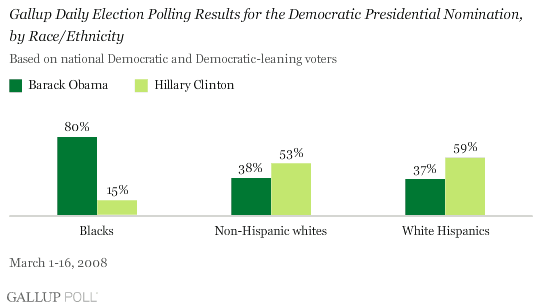PRINCETON, NJ -- Barack Obama's major speech on race in Philadelphia Tuesday is a reminder of the continuing, and highly charged, impact of race in American society and in this presidential campaign.

Obama, confronted with the continuing controversy over statements made by his former minister, Rev. Jeremiah Wright, tried to limit the damage by discussing what he called "a misunderstanding that exists between the races." Obama's speech presumably had the objective of shoring up as much white support for his presidential candidacy as possible among Democratic voters, particularly in the large state of Pennsylvania, the location for his speech and a state that holds its Democratic primary on April 22.
There is a large racial divide in the Democratic presidential campaign at this point. In Gallup Poll Daily election tracking, race is the single issue that divides the Democratic electorate more than any other. In an aggregate of 6,721 interviews Gallup has conducted between March 1 and March 16, 80% of black Democrats support Obama while only 15% support Hillary Clinton. Non-Hispanic whites split 53% for Clinton and 38% for Obama, while white Hispanics are even stronger for Clinton, 59% to 37%.
While Obama's focus at this point is largely on his attempt to win the Democratic nomination, his viability in the general election (should he win the nomination) will also be affected by white voters' views of his candidacy. At this time, however, there is very little racial divide between Obama and Clinton in Gallup's general election matchups. Blacks overwhelmingly support either Democratic candidate over John McCain, as would be expected given historical voting patterns. There is little significant difference in black or white support for the Democratic candidate against McCain, whether that candidate is Obama or Clinton.
Survey Methods
Gallup is interviewing no fewer than 1,000 U.S. adults nationwide each day during 2008.
The Democratic nomination results are based on combined data from March 1-16, 2008. For results based on this sample of 6,721 Democratic and Democratic-leaning voters, the maximum margin of sampling error is ±2 percentage points.
In addition to sampling error, question wording and practical difficulties in conducting surveys can introduce error or bias into the findings of public opinion polls.
